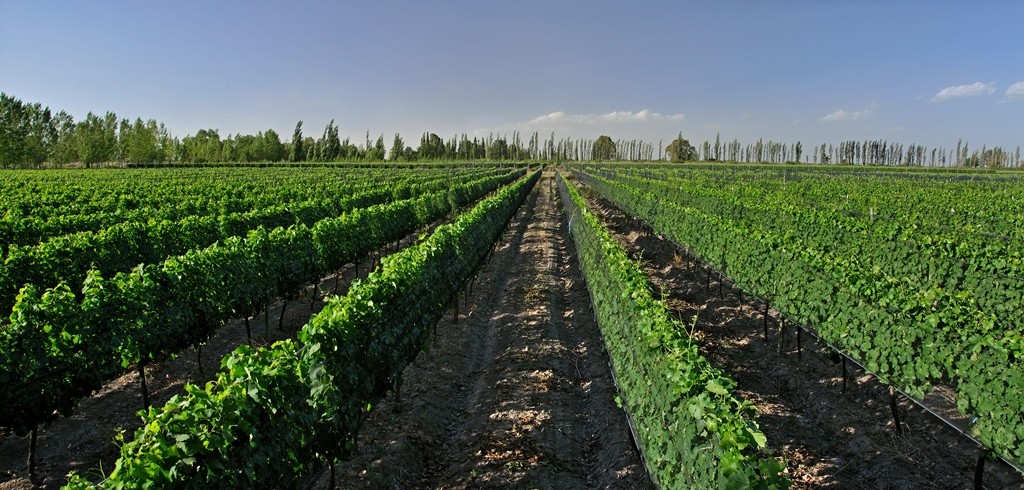Mendoza is well known for its high altitude terroirs. However, there are a handful of lower regions, and with the combination of soil and climates exposed to the southern winds, they offer a delicate balance for some varieties, especially reds.
San Rafael is a perfect example.
With more than a century of history and located just 240km south of the capital city of Mendoza, San Rafael is an oasis which should be visited. Not on the way to other regions, as has sometimes been the case, and is why its producers and wines became a distant thought, more in symbolic terms than real ones. However years ago, some wineries and winemakers decided to bridge the gap with consumers, under the slogan “Wines of San Rafael, Terroir with History”.They set out to show the world the potential of their wines without betraying their roots. And now comes the move to the global market, with some classic wines and other newer ones.
Self-expression
With 14,500 acres of vineyards, San Rafael is the southern border of Mendocino viticulture. Its vineyards are framed by a wonderful environment between the Atuel and Diamante rivers, a natural source to irrigate the vines.
Unlike other wine regions of Mendoza, its vineyards are far from the Andes Mountains, whose peaks can be seen just to the west, at around 600-800 meters above sea level. This results in a moderately cold, dry climate with excellent insolation. That difference can be seen in ” good acidity and a lively palate, principally in Malbec and the whites” says Facundo Pereira, winemaker of Casa Bianchi, the most important winery of the region.
Despite the distance from the mountains, the soils are alluvial, albeit with less stones. “Our soils are deep and plentiful in sand, clay and gravel. This results in softer wines, with well rounded tannins and an enveloping texture, “says Mauro Nosenzo, winemaker at Algodon Wine Estates.
Fresh reds
The variety Bonarda, stands out in the region. “We have old vineyards that offer impressive quality,” says Nosenzo enthusiastically, who tends to a vineyard from 1946. The age of the plants ensures good luminosity which creates maturity, while the cold preserves freshness, two aspects which allow for the elaboration of tasty, young, varietals, like Algodon Estates 2012, Via Blanca 2013 or Alfredo Roca Fincas 2013. But there is also room for the exponents of high-end wines, with good fruit on the palate and a new expression of complexity and elegance. To understand this new character of Bonarda, look out for the new label from Goyenechea, Lorenza 2012, the deep, Cavas de Don Nicasio 2011from Bodega Iaccarini, or the lively Alfredo Roca Dedicación Personal 2010. Each one, with its own profile which takes the varietal to a new dimension.
While in many regions of the country, we have seen a renewed enthusiasm for Cabernet Sauvignon, in San Rafael, it has always been one of its great reds. Not only as a varietal, but also at the heart of many blends, such as Enzo Bianchi´s Grand Cru, one of the most exclusive in the country. Today, the varietals exploit the traditional herbal freshness of San Rafael, which serves as a contrast to black fruit, berries and spices. To test this, simply look for the 5th generation Gran Reserva 2010 from Goyenechea, made by the young blood of the family, or La Espera Reserva 2010 from the newcomer, the Funckenhausen family or Bianchi Particular 2009 from Casa Bianchi. All of them wines which show that the king of reds has much to say in San Rafael.
As for Malbec, it covers 14% of the area of San Rafael and offers expressive, large and juicy wines – a product of cooler weather. The result is fruity varietals which are intense on the palate, something which in 2014 earned Casa Bianchi the distinction of Best Red Wine in the World at the Vinalies Internationales competition, with Famiglia Bianchi Malbec 2012. “This Malbec is one of the kindest and most vivacious in Argentina, “says Pereira, creator of this consecrated label. However, there are many other Malbecs with their own style to uncork in San Rafael. Among those which add diversity and are young and fresh, is Lavaque Malbec 2014 and La Espera Malbec 2012. While, 135 Anniversary 2010 from Bodega Goyenechea, Jean Rivier Reserve 2012 and Alfredo Roca Reserva de la Familia 2010, all deserve a special mention for their excellent quality.
White paradise
Due to its location, to the south of the province, San Rafael is the origin of glorious whites. Tasty and simple wines made from Chenin Blanc, Semillon, Chardonnay or Tocai. The point is that the whole region has some southern exposure and is exposed to the masses of cold air from Patagonia, so the whites get freshness and subtlety. To discover them, you can find the relaunched but still traditional Suter Etiqueta Marrón 2014, made with Chenin, a strain that is booming among winemakers seeking to recover classics from another time. Other Chenin Blancs to look out for are the varietals of Alfredo Roca and Jean Rivier. Meanwhile, Semillon is having a similar effect and this classic white is slowly regaining ground thanks to labels such as Iaccarini Semillon 2013, which brings out the austere and refreshing profile of the varietal.
As has been said before, there are many excuses to visit San Rafael, and not only for its great classic wines, but also to project the region into the future. This can already be seen in its newest wines. The rest is just a matter of time.
Ph: http://www.guiahoteleraon-line.com/localidad.php?idlocalidad=135



